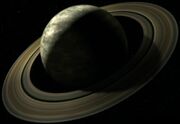(added pic) |
m (Robot: Automated text replacement (-{{[Nn]Cwiki +{{mbeta)) Tag: apiedit |
||
| (32 intermediate revisions by 27 users not shown) | |||
| Line 1: | Line 1: | ||
| − | [[ |
+ | [[File:Class D planet, Emanations.jpg|thumb|A ringed class D planet]] |
| + | In the [[Federation]] standard system of [[planetary classification]], a '''class D''' [[planet]] was characterized as a small, rock-based body, such as an [[asteroid]], [[moon]] or other barren, cratered [[planetoid]] with little or no [[atmosphere]]. |
||
| + | The planet known as [[Weytahn]] to the [[Andorian]]s and Paan Mokar to [[Vulcan]]s is an example of a class D world. Weytahn was class D before [[terraforming]]. It was described as being not much larger than [[Earth]]'s [[Luna|moon]]. ({{ENT|Cease Fire}}) [[Regula]], which was described as a "great rock in [[space]]" with a few "unremarkable [[ore]]s," was also a class D planet. ({{film|2}}) |
||
| − | [[Regula]] was described as a great rock in space with a few unremarkable ores. It was a Class D world. (''[[Star Trek II: The Wrath of Khan]]'') |
||
| ⚫ | |||
| ⚫ | |||
| ⚫ | |||
| ⚫ | |||
| + | {{bginfo|According to ''[[Star Trek: Star Charts]]'', on page 23, a Class D world had an average age of two to ten billion years, had a diameter of 100 to 1,000 kilometers, could be found in every zone of a [[star system]], could be found in greater numbers around larger planets or in [[asteroid belt]]s, had a barren and cratered surface, and had little to no atmosphere. An example given of a Class D world was [[Luna]].}} |
||
| − | The planet known as Weytahn to the Andorians and Paan Mokar to Vulcans was Class D before terraforming. It was described as being not much larger than the moon. ([[ENT]]: "[[Cease Fire]]") |
||
| + | {{Planetary classification}} |
||
| − | ==Background== |
||
| + | |||
| − | The non-canon publication [[Star Trek: Star Charts]] specifies that a Class D world has an average age of 2 to 10 billion years, and includes [[Luna]] and [[Derna]] as additional bodies of this class. |
||
| + | == External link == |
||
| ⚫ | |||
| + | * {{mbeta|Class D planet}} |
||
[[de:Klasse D]] |
[[de:Klasse D]] |
||
| + | [[ru:Класс D]] |
||
[[es:Clase D]] |
[[es:Clase D]] |
||
| + | [[ja:Dクラス]] |
||
[[nl:Klasse D]] |
[[nl:Klasse D]] |
||
| + | [[Category:Astronomical classifications|D]] |
||
| ⚫ | |||
Revision as of 20:37, 4 July 2015

A ringed class D planet
In the Federation standard system of planetary classification, a class D planet was characterized as a small, rock-based body, such as an asteroid, moon or other barren, cratered planetoid with little or no atmosphere.
The planet known as Weytahn to the Andorians and Paan Mokar to Vulcans is an example of a class D world. Weytahn was class D before terraforming. It was described as being not much larger than Earth's moon. (ENT: "Cease Fire") Regula, which was described as a "great rock in space" with a few "unremarkable ores," was also a class D planet. (Star Trek II: The Wrath of Khan)
In 2371, the USS Voyager found a ringed planet in the Delta Quadrant which was also class D. Some of the asteroids comprising the rings were big enough to have class M environments inside them. (VOY: "Emanations")
A subspace sinkhole encountered by the Voyager in 2375 led to a subspace pocket, where a star system composed of a G-type star and three planets was located. One of these planets was class D. It was described as hot, arid, and rocky. (VOY: "Gravity")
| Planetary classification |
|---|
| B • D • G • H • J • K • L • M • N • R • T • Y • Other classes |
External link
- Class D planet at Memory Beta, the wiki for licensed Star Trek works
